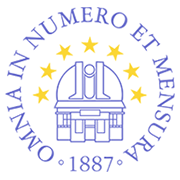

Comparison between the simulated Keplerian orbit of the S2 star (red dashed line) and its orbit in modified Rn gravity (blue solid line) around the central supermassive black hole Sgr A* of the Milky Way during 75 orbital periods.
The Gravitation and Cosmology Research Group conducts investigations of gravitation and related astronomical and cosmological phenomena and objects. These investigations include theoretical considerations, numerical simulations and comparisons of the obtained results with astronomical observations, and their main scientific goal is to obtain new fundamental knowledge about the gravitational interaction and its effects on different astrophysical scales, from the Solar System, through galactic, extragalactic to cosmological scales.
Research topics:
- Single and binary black holes in the centers of galaxies and quasars, as well as their relativistic effects (e.g. orbital precession and gravitational redshift)
- Gravitational waves (from massive binary systems and primordial ones) and the corresponding electromagnetic effects of their sources
- Gravitational lenses and their application in observational cosmology and for studying the distribution of visible and dark matter in source and lens galaxies
- Testing the predictions of the standard (General Relativity) and modified gravity theories using astronomical observations
- Standard ΛCDM, as well as cosmological models based on alternative theories of gravity and their ability to explain the Hubble tension
- Explaining the observed galactic and extragalactic dynamics (the baryonic Tully-Fisher relation of spiral galaxies and the fundamental plane of elliptical galaxies), as well as the observed anomalies in the motion of the Solar System planets without the dark matter hypothesis
- Extreme accreting quasars as distance indicators in cosmology
- Variability of active galaxies and quasars through spectroscopic monitorings (time series analysis with simultaneous line and SED modeling of quasar monitoring spectra)
- Nonlinear density wave theory in galactic dynamics explaining flat rotation curves
- Ultra high energy cosmic rays acceleration in plasma wave turbulence
Members:
- Predrag Jovanović (PI), principal research fellow
- Nataša Bon, senior research associate
- Edi Bon, senior research associate
- Miroslava Vukčević, research associate
Subgroup for Astroinformatics
Research topics:
- SerVO – Serbian Virtual Observatory web portal of the group (servo.aob.rs) hosts a variety of services, data queries as well as conference web pages/archives
- Collaboration with some of the largest and most important international projects of the decade – LSST, VAMDC
- Collaboration with Institute of Physics Belgrade on A&M datasets and databases, integrated in the distributed international interoperable network of nodes - VAMDC.
- Three official VAMDC nodes hosted on servo
- Types of processes: collisional (excitation, ionization, recombination, elastic, inelastic, etc.), photodissociation etc.
- LSST (now Rubin Observatory) – close collaboration from early 2010’s
- Scientific association with TVS (transients) and DESC (dark energy) groups
- Work on AlertSim – alert simulator within lsst_sims, an internal LSST workgroup for simulations, which resulted in data rights and PI+5JA slots for the group
- Transient and variable stars – real time detection and classification
- Active observation and photometric survey of binary asteroids
- Work and administration on Fermi supercomputer consisting of 12nodes x 12cores
Members:
- Veljko Vujčić (subgroup PI), senior technical associate
- Vladimir Benišek, technical associate
- Nenad Milovanović, technical associate
- Sanja Erkapić, technical associate
- Vesna Mijatović, technical associate



